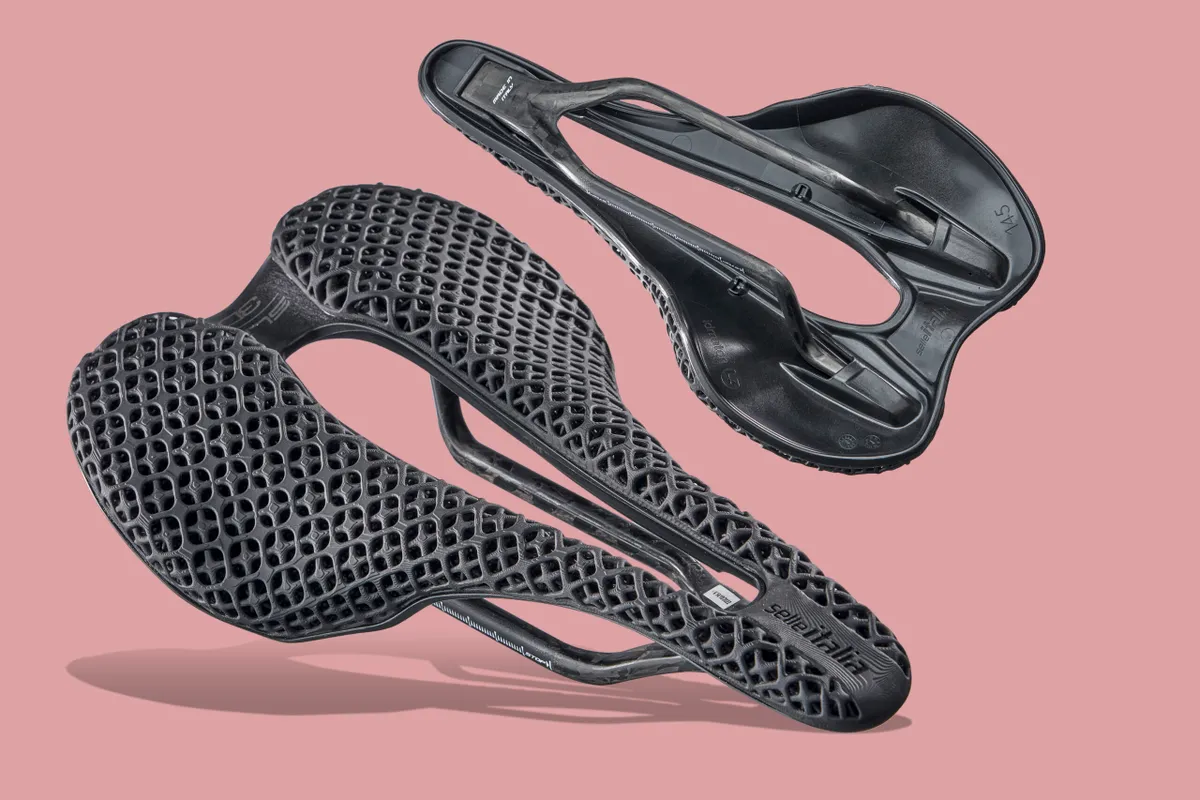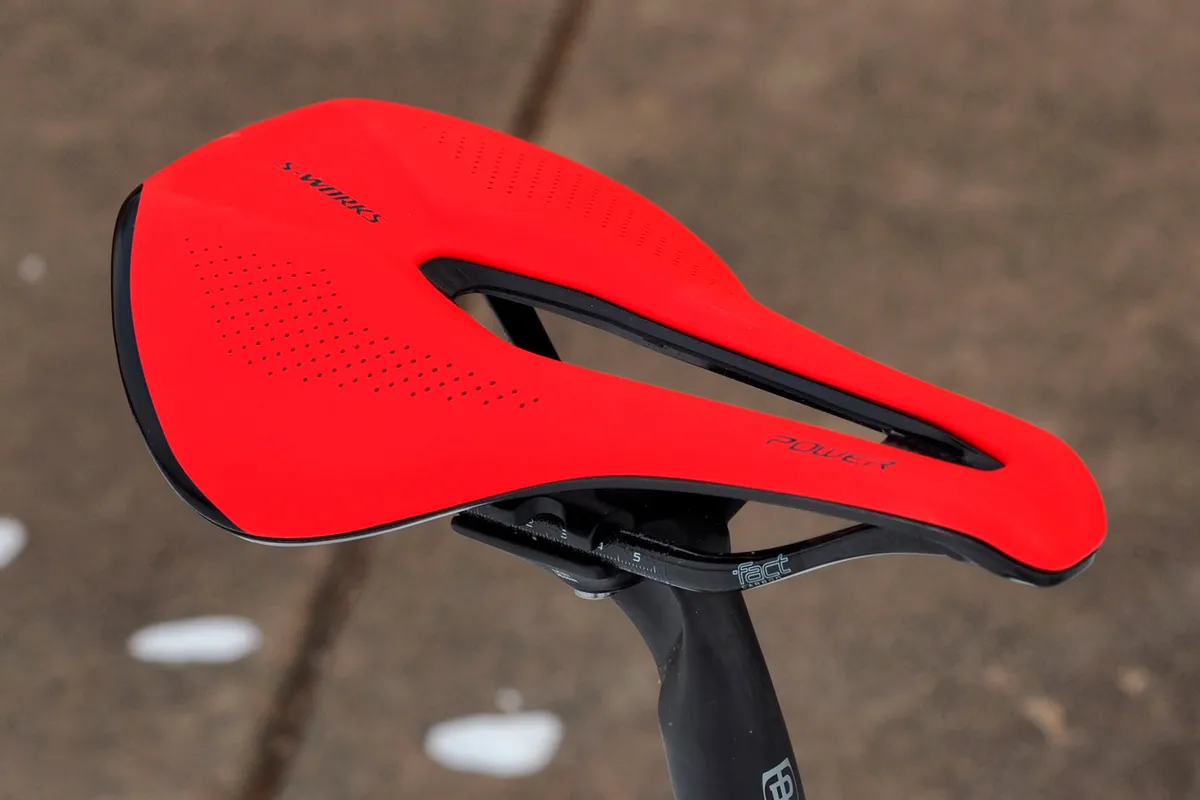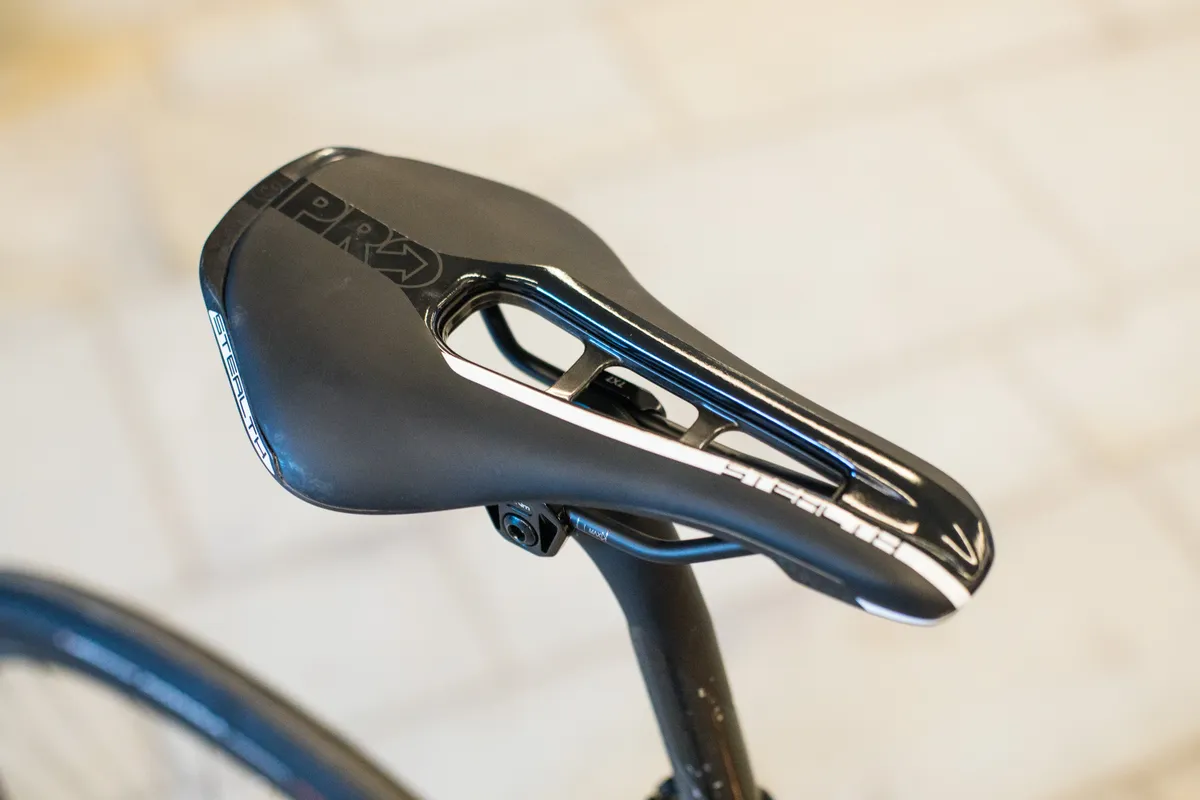The best short-nose saddles prove less is more when it comes to saddle comfort, aerodynamics and pedalling efficiency.
Since Specialized released the S-Works Power saddle in 2015, short-nose saddles have grown in popularity. Now the likes of Fizik, Selle Italia and Cadex produce their own versions.
If you’re overwhelmed with choice and would like to find the best short saddle for you, you’re in luck. In this article, we’ve compiled the best short-nose saddles we’ve tested.
You can skip to our short-nose saddles buyer’s guide for more information about these stubby bike seats. Alex Locatelli, product manager at Fizik, bike fitter Dan Smith from UK Bike Fit, and Jeff Schneider, global head of product and marketing at Cadex and Giant group, have helped us explain all you need to know about short saddles.
Head to our guides to the best road bike saddles if you’d like to consider long saddles too, as well as the best mountain bike saddles for off-road options.
Most short saddles will suit men and women, but we also have separate guides to the best women's road bike saddles and mountain bike saddles.
Editor's note: this best list was updated on 14 March 2025 to include new product entries from recent rounds of testing, including options from Specialized and Fizik, and remove models that have since been discontinued.
Best short-nose saddles 2025, as reviewed by our expert testers
Prologo Scratch M5 AGX Tirox
SQUIRREL_TEXT_13082241

- £120 / €139 as tested
- Pros: Good pedalling freedom; sit-bone support
- Cons: Only one width option
The Prologo Scratch M5 AGX became our tester's favourite off-road saddle. It has thicker padding, a more flexible shell and a grippier surface than the road-focused Scratch M5, but still rides well on tarmac.
The short nose gives ample pedalling freedom. Our tester found the central cut-out in the shell enabled the padding to dip in the middle, relieving pressure while proving more supportive than a padding cut-out.
Measuring 240x140mm, with alloy rails and a carbon hull, the Scratch M5 AGX weighs a decent 220g.
SQUIRREL_13082241
Selle Italia Novus Boost Evo 3D Kit Carbonio Superflow
SQUIRREL_TEXT_13076543

- £399.99 / $449.90 / €429.90 as tested
- Pros: Excellent shape; 3D-printed padding gives great comfort
- Cons: Very expensive
Measuring 245x145mm, the Selle Italia Novus Boost Evo 3D Kit Carbonio Superflow is a short-nose saddle with 3D-printed padding.
The carbon hull and rails balance compliance and support, while a long central cut-out prevents soft-tissue irritation.
3D-printed padding makes the Novus Boost Evo 3D Kit Carbonio Superflow comfortable to ride for hours in an aggressive position. However, it contributes to an extravagant price tag.
SQUIRREL_13076543
Specialized Power Comp with MIMIC
SQUIRREL_TEXT_13083664

- £95 / $140 / €110 as tested
- Pros: Comfortable ride feel; three widths
- Cons: All-day comfort compromised; lack of cut-out won't suit all
Originally designed for women, the Specialized Power Comp with MIMIC is an excellent short-nose saddle that should suit a wide range of riders.
The MIMIC material at the nose and slight cut-out is designed to replicate soft tissue, hence reducing any pressure issues in this delicate area. Thousands of foam beads replace traditional foam blocks here to achieve this.
There are three widths to choose from (143mm, 155mm and 168mm), and at 234g for the 155mm model tested, it's a decent weight for the price too.
SQUIRREL_13083664
Cadex Boost
SQUIRREL_TEXT_13092202

- £300 / $300 / €250 / AU$400 as tested
- Pros: Very light; brilliant comfort
- Cons: Very pricey
The 139g Cadex Boost is one of the lightest saddles available that you'd want to sit on for hours at a time.
Its comfort and low weight come from the excellent padding (a combination of traditional foam and springier ETPU) and innovative rail design. The rails run right to the back of the base, boosting compliance and cutting grams because there's no need for the excess material of a joint.
However, for a short-nose saddle without 3D padding, the Cadex Boost is very pricey.
SQUIRREL_13092202
Fizik Terra Argo X5
SQUIRREL_TEXT_13194077

- £90 as tested
- Pros: Comfortable shape and padding; all-weather ready
- Cons: A little weighty
The Fizik Terra Argo X5 is a gravel-specific saddle, building on the success of the brand's popular short-nosed Argo.
The Terra Argo X5 features more of a curved profile, designed to suit a more upright riding position, while the hull and wings are more compliant to enhance comfort over rougher terrain.
The deep relief channel also features a thin rubber insert with a rear-facing drainage hole, meaning you won't have to suffer puddle splash and tyre spray up through your saddle's cut-out when riding in poor weather conditions.
SQUIRREL_13194077
Repente Latus M Carbon
SQUIRREL_TEXT_13115143

- £210 / €210 / AU$389 as tested
- Pros: Carbon rails with plenty of adjustment; very comfortable for the weight
- Cons: Pricey
The Repente Latus M Carbon is a flat, wide and short saddle that facilitates an aggressive riding position.
Carbon rails reduce weight to an impressive 140g, while damping road vibrations and enabling lots of setback adjustment. A central pressure-relief channel enhances the comfort of the well-cushioned cover.
Such performance doesn't come cheap though.
SQUIRREL_3115143
Selle Italia Novus Boost EVO Superflow
SQUIRREL_TEXT_13082154

- £75 / $75 / €84.90 / AU$85 as tested
- Pros: Good value; wide pressure-relief cut-out
- Cons: Firm nylon hull
The Selle Italia Novus Boost EVO Superflow provides impressive performance for a short saddle at this price.
At 247g, its weight is decent too, while the build quality seems high.
The Novus Boost EVO Superflow's nylon hull is on the firm side. But the saddle's padding and cut-out generally make it a supportive and comfortable perch.
SQUIRREL_13082154
Selle Italia SLR Boost 3D Kit Carbonio Superflow
SQUIRREL_TEXT_13194061

- £410 / $479.90 / €449.90 / AU$449.90 as tested
- Pros: Low weight; excellent comfort
- Cons: Very pricey option
The Selle Italia SLR Boost 3D Kit Carbonio Superflow is a wonderfully comfy short saddle thanks to the plush, 3D-printed padding covering its compliant base.
Weighing just 174g, it's very light for a saddle this comfortable.
But a formidable price tag accompanies the SLR Boost 3D Kit Carbonio Superflow's premier performance.
SQUIRREL_13194061
Selle Italia SLR Boost Tekno Superflow
SQUIRREL_TEXT_13121061

- £409.99 / $529.99 / €469.90 / AU$469.90 as tested
- Pros: Super-light; impressive comfort
- Cons: Hefty price tag; slippery when wet
Despite weighing a 'barely-there' 97.2g, the Selle Italia SLR Boost Tekno Superflow proved remarkably rideable in testing.
The carbon hull is sufficiently flexible to counteract the gossamer-thin padding. The cut-out prevented any soft-tissue discomfort while tilting forwards on the saddle.
But the slick, matt finish is a bit slippery in the wet and then there's the astronomic cost to consider.
SQUIRREL_13121061
Specialized S-Works Power with Mirror
SQUIRREL_TEXT_13079399

- £350 / $450 / €400 / AU$700 as tested
- Pros: Incredible comfort
- Cons: Staggeringly expensive; hard to clean
The Specialized S-Works Power with Mirror is a 3D-printed version of the brand's Power short saddle.
Laying a polymer lattice of variable density over the winning Power shape produces an extremely comfortable saddle.
But our tester took umbrage at the enormous additional cost and the difficulty of keeping the saddle cover clean.
SQUIRREL_13079399
Why you can trust BikeRadar
BikeRadar has been an authority on bikes and cycling tech since its inception in 2007, delivering the world’s best riding advice.
We have experts testing all types of bikes, parts, clothing and accessories, from road, mountain and gravel bikes to commuting, bikepacking and electric bikes.
Our reviews are always editorially independent – with no exceptions. Our reviewers comprehensively test all products in the real world, always reflecting on performance, value and the wider market when delivering their verdicts and review ratings.
When you see a product listed in our buyer’s guides, you can be confident that it’s worthy of your attention. Only gear that we’ve ridden and rated 4 stars and above are included. In some cases, we’ll also highlight some of our other contenders that narrowly missed out with 3.5 stars or below.
We have more than 15,000 product reviews available at your fingertips, as well as expert buying, maintenance, training, skills, health and fitness advice.
Our annual Bike of the Year test is an industry benchmark and the BikeRadar team consists of some of the most experienced riders and testers in the business.
Short-nose saddles buyer’s guide
What is a short-nose saddle?

A short-nose saddle is shorter and wider than a conventional saddle, and can make riding in an aggressive, aerodynamic position more comfortable.
A typical short-nose saddle is about 245mm long, 30mm shorter than a standard saddle.
Unlike a conventional saddle with a narrow, pointy tip, the front of a short-nose saddle is usually square.

Because you can comfortably adopt an aggressive position, short-nose saddles were common on time-trial bikes long before their adoption on the road.
Short-nose saddles often but not always have a cut-out. This is a channel running through the saddle that's designed to relieve pressure on soft tissue in contact with the saddle.
A typical road bike saddle will measure 145mm wide, although some short-nose saddles are available in wider sizes, up to 155mm wide.
Depending on whether they have carbon saddle rails, a short-nose saddle can be lighter than many longer road bike saddles.
How do short-nose saddles work?

Short-nose saddles are designed to load the pelvis at the square-shaped front of the saddle. This area supports your anatomy as you lean forwards into a low and flat position.
“As you roll the pelvis forward, the shape of the pelvis becomes narrower towards the pubic bone at the front of the pelvis,” says Dan Smith from UK Bike Fit.
“That's the shape that the saddle is trying to mimic and support.”

As a result, Smith finds that people who anteriorly tilt through the pelvis and get into a more aggressive position are best suited to short-nose saddles.
In his view, riders who sit a little bit more upright or posteriorly tilt the pelvis and have a flattened back shape will be better on a longer-nose saddle.
Smith says the cut-out (found on most short-nose saddles) will run almost from the nose but not right to the back – that’s because you’re meant to sit in the front half of the saddle.

The shape of the cut-out varies from narrow to wide, as on the Pro Stealth, for example.
For some people who load more weight forwards, compressing soft tissue at the front of the saddle, a wide cut-out is necessary to avoid numbness from nerve compression on the perineum, according to Smith.

According to Schneider, a critical feature in a short-nose saddle is padding at the front of the saddle.
The idea is you sit squarely on a short-nose saddle. However, during hard efforts, he says some riders still creep forwards in a bid to maximise pedalling efficiency.
“If it is shorter, you have to compensate by adding different or additional padding to the front of the saddle,” he says.
What are the benefits of a short-nose saddle?

Short-nose saddles are best for riders who tilt their pelvis forward into a low, aggressive position.
Fizik's Alex Locatelli says the longer nose of a traditional saddle can catch against soft tissue because you rest more weight towards the tip of the saddle.
On a short-nose saddle, you have less room to move about, which encourages you to sit in a fixed position.
Excessive movement in the saddle can trigger the most common types of pain caused by cycling, especially lower back pain and saddle sores.
Bike fitter Smith explains that a UCI rule governing saddle position influenced the development of the Specialized Power saddle.
However, this type of saddle also benefits riders who are not subject to UCI regulations.

Removing the tip of the saddle effectively brings the middle closer to the bottom bracket.
Smith says: “This positions the body a little bit further forward over the bike into a more aero and powerful position and opens up the hips.”
A more open hip position often alleviates hip pain from cycling.
As we found during some wind tunnel testing, a wind-cheating body position is one of the cheapest and most effective aero upgrades.
What are the disadvantages of a short-nose saddle?
Fixed, aggressive position on the bike

The fixed, aggressive position a short-nose saddle creates can limit riders who like to move around on the saddle.
Jeff Schneider notes that riders who like a short-nose saddle on their road bike may not feel the same about their gravel bike.
“They feel they need to move around more [off-road] to adjust their body position,” he explains.
More upright cyclists, who put more weight on their sit bones, are unlikely to find short-nose saddles comfortable, according to Smith.
“As you pedal in that position on a short-nose saddle, because the wings of the saddle normally flare out quite widely from where you're designed to sit on it [from the middle to the front] you chafe and catch the back of your thighs on the saddle,” he explains.
On the other hand, when you tilt your pelvis forwards and sit on the front of the saddle, you shouldn’t catch your thigh on the back of the saddle.
Cut-outs

Most short-nose saddles have cut-outs, which don’t suit everyone.
Although he recommends a wide cut-out in general, Smith adds: “It can cause other issues, such as chafing of soft tissue in females and males.
“The edges of a wide cut-out can get in the way.”
Short-nose saddles with a cut-out filled in with soft material, such as the Specialized Mimic, have previously been marketed to women.
This is because some women find sharper edges of other cut-outs cause soft-tissue discomfort.
“But there’s a large crossover between men’s and women’s saddles, which I think is why a lot of brands don’t call their saddles ‘women-specific’,” he adds.
During bike fits, Smith says some women prefer the Specialized Power, the men’s version of the Mimic. Men, meanwhile, can sit better on unisex or women’s saddles.
Potentially less compliance

Short-nose saddles can be less compliant than longer saddles because they have less rail to absorb vibrations, according to Schneider.
Therefore, on the new Cadex Amp saddle, the rails run right to the front of the saddle, maximising their length, which Cadex claims improves comfort.
A number of short-nose saddles are 3D-printed. This should mean they have more compliance, but it tends to increase the price.
